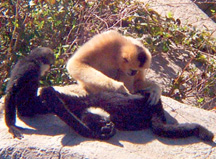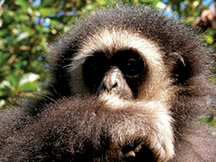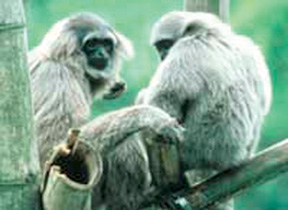|
observer |
|
|
|
|
|
OTHER LINKS |

|

|

|
|
|
|
|
Gibbons are not only admired for the so-called 'singing' prowess (skill), but also for their agility and acrobatic skills. They have remarkable power and grace when swinging from trees.
It is their skill at walking on small branches high up in the tree canopy, like tight-rope walkers, with their arms stretched out to keep the balance, and their ability to leap across large gaps of over 30 feet from branch to branch, that makes them the greatest acrobats of the forests.
However, when they are on the ground, they avoid water as they are poor swimmers and usually bipedal (walk on two legs) to get from one place to another, especially in search of food.
What they look like...
The gibbons are small bodied apes which are different from great apes such as chimpanzees, gorillas, orang-utans and humans. They are light in weight with small round heads, short, slender bodies with no tails (like all apes) and arms which are longer than their legs.
|
|
The hands are similar to those of humans' and consist of four long fingers plus a small opposable thumb. They also have five toes including a big toe. When they are brachiating (swinging through trees) they use their four fingers like a hook, but not the thumb. They can turn most of their joints 360 degrees; they hang on a branch and rotate on their own axis.
Their coats are light coloured to dark brown or black, and are dense. Some species have different colours and this change comes with maturity or gender differences, and range from jet black to silver, rufus or brown. However, their faces, armpits, palms and fingers are hairless.
Some species have a band of white fur surrounding their face. The eyes are dark and the nostrils are small. The male gibbons which are generally bigger than the females, weigh around 15 pounds and are about three feet in length.
Diet and babies
|
|
Gibbons are omnivorous and forage for food during the day time. Fruits contain 75 per cent of their diet and the balance is made up of leaves, seeds, flowers, tree bark, tender plant shoots, insects, spiders, bird eggs and small vertebrae.
The females who are ready to become mums when they reach their teens (12-13 years) give birth to a single baby after a seven month pregnancy. Twins are very rare among gibbons.
The new born gibbon is hairless, except for a small cap of fur on the top of its head. The baby is carefully nurtured by its mother. The infant's hands are strong, as it can grasp its mum's fur to get on to her belly soon after it's born. They are weaned off mother's milk by one year, but stay close to her until they reach six years. Gibbons live up to 35-40 years in the wild, though they are fast disappearing today.
Behaviour and their territories
Gibbons are social creatures and live in small stable family groups consisting of a male and female who are lifetime partners, and their offspring who are under seven years. They are unique among apes in keeping and strictly defending their territories in which they live, at all times.
|
|
The family territory may be around 30-50 acres of old-growth rain-forests. They announce their presence every morning by using a territorial hooting and menacing gestures. This noisy display which has also earned them the name of 'singers' of the forest is usually started by the female. The calls the males and the females make are different.
The Siamang gibbon, which is the largest has an inflatable throat sac called a gular sac which can be inflated as big as its head. It is a resonating (echoing) chamber for its vocal cords, making the sounds it makes even louder.
Gibbons are diurnal (active at day) and arboreal (spend most of their lives on trees). Their senses are similar to our's, including hearing, colour, vision, smell, taste and touch. They enjoy grooming and take great pains to clean the hair of their family members, of any irritating parasites.
|
|
Unlike other apes, gibbons do not make 'sleeping nests' on trees or elsewhere. They usually sleep huddled together in upright positions. Guess how they avoid having sore bottoms staying seated for long on rough tree branches? Thanks to their 'natural pillows' the tough pads on their bottoms.
Gibbon species
Some of the species of gibbons are the Hoolock gibbon, Javan gibbon, Bornean Kloss' gibbon, Red-cheeked gibbon, Crested or Black gibbon, White-cheeked gibbon and White-handed or common gibbon, which also has about three sub species.














